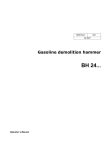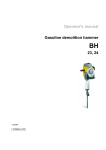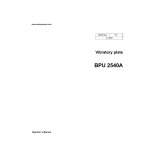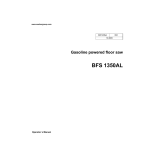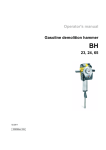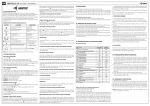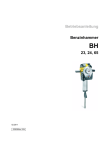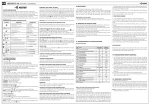Download Wacker Neuson BH 23 Operator`s manual
Transcript
www.wackergroup.com PETROL BREAKER BH 23... 0109963en - 03.2004 0007891 101 0007892 101 0007893 101 0007894 101 Operator´s Manual 1. Important information This machine has been equipped with an EPA certified engine. Additional information manufacturers notes. can be found in the engine WARNING The engine exhaust from this product contains chemicals known to the State of California to cause cancer, birth defects or other reproductive harm. Caution This engine is an EPA engine. Adjusting the engine speed will interfere with EPA certivication and emissions. Only authorized personnel can make adjustments to this engine. Please contact you nearest Motor dealer or your Wacker Dealer for more information. T00940GB 1 T00940GB 2 Emission Control System Infor2. Emission Control System Information Source of Emissions The combustion process produces carbon monoxide, oxides of nitrogen, and hydrocarbons. Control of hydrocarbons and oxides of nitrogen is very important because, under certain conditions, they react to form photochemical smog when subjected to sunlight. Carbon monoxide does not react in the same way, but it is toxic. Wacker utilizes lean carburetor settings and other systems to reduce the emissions of carbon monoxide, oxides of nitrogen, and hydrocarbons. The U.S. and California Clean Air Acts EPA and California regulations require all manufacturers to furnish written instructions describing the operation and maintenance of emission control systems. The following instructions and procedures must be followed in order to keep the emissions from your Wacker engine within the emissions standards. Tampering and Altering Tampering with or altering the emission control system may increase emissions beyond the legal limit. Among those acts that constitute tampering are: •Removal or alteration of any part of the intake, fuel, or exhaust systems. •Altering or defeating the speed-adjusting mechanism to cause the engine to operate outside its design parameters. Problems That May Affect Emissions If you are aware of any of the following symptoms, have your engine inspected and repaired by your servicing dealer. •Hard starting or stalling after starting. •Rough idle. •Misfiring or backfiring under load. •Afterburning (backfiring). •Black exhaust smoke or high fuel consumption. T00953GB 3 Emission Control System Information Replacement Parts The emission control systems on your Wacker engine were designed, built, and certified to conform with EPA and California emissions regulations. We recommend the use of genuine Wacker parts whenever you have maintenance done. These original-design replacement parts are manufactured to the same standards as the original parts, so you can be confident of their performance. The use of replacement parts that are not of the original design and quality may impair the effectiveness of your emission control system. A manufacturer of an aftermarket part assumes the responsibility that the part will not adversely affect emission performance. The manufacturer or rebuilder of the part must certify that use of the part will not result in a failure of the engine to comply with emission regulations. Maintenance Follow the maintenance schedule. Remember that this schedule is based on the assumption that your machine will be used for its designed purpose. Sustained high-load or high-temperature operation, or use in unusually wet or dusty conditions, will require more frequent service. OXYGENATED FUELS Some conventional gasolines are being blended with alcohol or an ether compound. These gasolines are collectively referred to as oxygenated fuels. To meet clean air standards, some areas of the United States and Canada use oxygenated fuels to help reduce emissions. If you use an oxygenated fuel, be sure it is unleaded and meets the minimum octane rating requirement. Before using an oxygenated fuel, try to confirm the fuel’s contents. Some States / Provinces require this information to be posted on the pump. The following are EPA-approved percentages of oxygenates: ETHANOL - (ethyl or grain alcohol) 10% by volume. You may use gasoline containing up to 10% ethanol by volume. Gasoline containing ethanol may be marketed under the name “Gasohol”. MTBE - (methyl tertiary butyl ether) 15% by volume. You may use gasoline containing up to 15% MTBE by volume. T00953GB 4 Emission Control System InforMETHANOL - (methyl or wood alcohol) 5% by volume. You may use gasoline containing up to 5% methanol by volume, as long as it contains cosolvents and corrosion inhibitors to protect the fuel system. Gasoline containing more than 5% methanol by volume may cause starting and/or performance problems. It may also damage metal, rubber, and plastic parts of your fuel system. If you notice any undesirable operating symptoms, try another service station, or switch to another brand of gasoline. Fuel system damage or performance problems resulting from the use of an oxygenated fuel containing more than the percentages of oxygenates mentioned above are not covered under warranty. Emission Control System Warranty Your new Wacker engine complies with the U.S. EPA emissions regulations. Wacker provides the same emission warranty coverage for engines sold in all 50 states. YOUR WARRANTY RIGHTS AND OBLIGATIONS All States Wacker must warrant the emission control system on your engine for the period of time listed below provided there has been no abuse, neglect or improper maintenance of your engine. Where a warrantable condition exists, Wacker will repair your engine at no cost to you including diagnosis, parts and labor. Your emission control system may include such parts as the carburetor, the ignition system and the catalytic converter. Also included may be hoses, connectors and other emission-related assemblies. MANUFACTURER’S WARRANTY COVERAGE: The 1998 and later engines are warranted for two years. If any emission-related part on your engine is defective, the part will be repaired or replaced by Wacker. T00953GB 5 Emission Control System Information OWNER’S WARRANTY RESPONSIBILITY: As the engine owner, you are responsible for the performance of the required maintenance listed in your owner’s manual. Wacker recommends that you retain all receipts covering maintenance on your engine, but Wacker cannot deny warranty coverage solely for the lack of receipts or for your failure to ensure the performance of all scheduled maintenance. As the engine owner, you should be aware that Wacker may deny you warranty coverage if your engine or a part has failed due to abuse, neglect, improper maintenance or unapproved modifications. You are responsible for presenting your engine to a Wacker dealer as soon as a problem exists. The warranty repairs should be completed in a reasonable amount of time, not to exceed 30 days. If you have any questions regarding your warranty rights and responsibilities, you should contact your local Wacker dealer. WARRANTY COVERAGE: Wacker engines sold after January 1, 1998, are covered by this Emission Control System Warranty for a period of two years from the date of delivery to the original retail purchaser. This warranty is transferable to each subsequent purchaser for the duration of the warranty period. Warranty repairs will be made without charge for diagnosis, parts or labor. All defective parts replaced under this warranty become property of Wacker. A list of warranted parts is located on the next page. Normal maintenance items, such as spark plugs and filters, that are on the warranted parts list are warranted up to the required replacement interval only. Wacker is also liable for damages to other engine components caused by a failure of any warranted parts during the warranty period. Only Wacker approved replacement parts may be used in the performance of any warranty repairs and must be provided without charge to the owner. The use of replacement parts not equivalent to the original parts may impair the effectiveness of your engine emission control system. If such a replacement part is used in the repair or maintenance of your engine, and an authorized Wacker dealer determines it is defective or causes a failure of a warranted part, your claim for repair of your engine may be denied. If the part in question is not related to the reason your engine requires repair, your claim will not be denied. T00953GB 6 Emission Control System InforTO OBTAIN WARRANTY SERVICE: You must take your Wacker product along with proof of original purchase date, at your expense, to any Wacker authorized dealer during their normal business hours. Claims for repair or adjustment found to be caused solely by defects in material or workmanship will not be denied because the engine was not properly maintained and used. EXCLUSIONS: FAILURES OTHER THAN THOSE RESULTING FROM DEFECTS IN MATERIAL OR WORKMANSHIP ARE NOT COVERED BY THIS WARRANTY. THIS WARRANTY DOES NOT EXTEND TO EMISSION CONTROL SYSTEMS OR PARTS WHICH ARE AFFECTED OR DAMAGED BY OWNER ABUSE, NEGLECT, IMPROPER MAINTENANCE, MISUSE, MISFUELING, IMPROPER STORAGE, ACCIDENT AND/OR COLLISION, THE INCORPORATION OF, OR ANY USE OF, ANY ADD-ON OR MODIFIED PARTS, UNSUITABLE ATTACHMENTS, OR THE UNAUTHORIZED ALTERATION OF ANY PART. THIS WARRANTY DOES NOT COVER REPLACEMENT OF EXPENDABLE MAINTENANCE ITEMS MADE IN CONNECTION WITH REQUIRED MAINTENANCE SERVICES AFTER THE ITEM’S FIRST SCHEDULED REPLACEMENT AS LISTED IN THE MAINTENANCE SECTION OF THE PRODUCT OWNER’S MANUAL, SUCH AS SPARK PLUGS AND FILTERS. DISCLAIMER OF CONSEQUENTIAL DAMAGE AND LIMITATIONS OF IMPLIED WARRANTIES: WACKER DISCLAIMS ANY RESPONSIBILITY FOR INCIDENTAL OR CONSEQUENTIAL DAMAGES SUCH AS LOSS OF TIME OR THE USE OF THE POWER EQUIPMENT, OR ANY COMMERCIAL LOSS DUE TO THE FAILURE OF THE EQUIPMENT; AND ANY IMPLIED WARRANTIES ARE LIMITED TO THE DURATION OF THIS WRITTEN WARRANTY. THIS WARRANTY IS APPLICABLE ONLY WHERE THE U.S. EPA EMISSION CONTROL SYSTEM WARRANTY REGULATION IS IN EFFECT. T00953GB 7 Emission Control System Information SYSTEMS COVERED BY THIS WARRANTY PARTS DESCRIPTIONS FUEL METERING CARBURETOR ASSEMBLY EXHAUST SYSTEM MUFFLER AIR INDUCTION AIR FILTER HOUSING AIR FILTER ELEMENT* IGNITION FLYWHEEL MAGNETO IGNITION MODULE SPARK PLUG CAP SPARK PLUG* MISCELLANEOUS PARTS TUBING, FITTINGS, SEALS, GASKETS AND CLAMPS ASSOCIATED WITH THESE LISTED ITEMS * Indicates expendable maintenance items. T00953GB 8 Operating instructions 1. Foreword For your own safety and protection from bodily injuries, carefully read, understand and follow the safety instructions in this manual. Please operate and maintain your Wacker machine in accordance with the instructions in this manual. Your Wacker machine will reward your attention by giving trouble-free operation and a high degree of availability. Defective machine parts are to be replaced as soon as possible. All rights, especially the right for copying and distribution are reserved Copyright by Wacker Construction Equipment AG No part of this publication may be reproduced in any form or by any means, electronic or mechanical, including photocopying, without express permission in writing from Wacker Construction Equipment AG. Any type of reproduction, distribution or saving on data carriers of any type or method not authorized by Wacker represents an infringement of valid copyrights and will be prosecuted. We expressly reserve the right to technical modifications - even without express due notice - which aim at improving our machines or their safety standards. 9 Table of contents 1. Important information 1 2. Emission Control System Information 3 3. Foreword 9 4. Safety instructions 4.1 4.2 4.3 4.4 4.5 4.6 12 General ............................................................................................... 12 Operation ............................................................................................ 12 Safety checks ..................................................................................... 14 Maintenance ....................................................................................... 14 Transport ............................................................................................ 15 Maintenance checks ........................................................................... 15 5. Technical Data 17 6. Description 19 6.1 6.2 6.3 6.4 7. Applications ........................................................................................ 19 Dimensions ......................................................................................... 19 Transport to work site ......................................................................... 20 Description of function ........................................................................ 20 Operation 7.1 7.2 7.3 7.4 7.5 21 Starting procedure .............................................................................. 21 Engine ................................................................................................ 21 During operation ................................................................................. 22 After operation .................................................................................... 22 Notes for correct working procedure .................................................. 23 10 Table of contents 8. Maintenance 8.1 8.2 8.3 8.4 8.5 9. 25 Maintenance schedule ....................................................................... 25 Engine ................................................................................................ 26 Percussion system, crankcase ........................................................... 26 Assembly instructions ......................................................................... 27 Assembly ............................................................................................ 28 Labels 29 EC - Confornity Certificate 31 DIN EN ISO 9001 CERTIFICATE 33 11 Safety instructions 2. Safety instructions for the use of drilling and breaking hammers with combustion engines 2.1 General 2.1.1 Drilling and breaking hammers may only be operated by persons who ∗ are at least 18 years of age, ∗ are physically and mentally fit for this job, ∗ have been instructed in operating drilling and breaking hammers and proven their ability for the job to the employer ∗ may be expected to carry out the job they are charged with carefully. The persons must be assigned the job of operating drilling and breaking hammers by the employer. 2.2 SV00044GB 2.1.2 Drilling and breaking hammers are to be applied for their proper use. Both the manufacturer’s operating instructions and these safety instructions have to be observed. 2.1.3 The persons charged with the operation of these hammers have to be made familiar with the necessary safety measures relating to the machine. In case of extraordinary uses, the employer shall give the necessary additional instructions. 2.1.4 It is possible that these drilling and breaking hammers exceed the admissible sound level of 89 dB (A). According to the rules for the prevention of accidents regarding emission of noise, the employees have to wear ear protection if the sound level reaches 89 dB (A) or more. Operation 2.2.1 The function of operation levers or elements is not to be influenced or rendered ineffective. 2.2.2 Before going on breaks, the operator has to switch of the engine and has to place the drilling and breaking hammer in such a manner that it cannot turn over. 2.2.3 Wear safety goggles in order to avoid injuries to the eyes. 2.2.4 We recommend wearing suitable working gloves. 12 Safety instructions SV00044GB 2.2.5 Wear safety shoes while working with drilling and breaking hammers. 2.2.6 Drilling and breaking hammers are always to be operated with both hands on the handles provided for this purpose. 2.2.7 When working with drilling and breaking hammers, especially when carrying out drilling jobs, the operator has to have a firm stand, particularly when working on scaffolding and ladders. 2.2.8 Drilling and breaking hammers are to be guided such that hand injuries caused by solid objects are avoided. When carrying out demolition jobs at elevated places, special care is required to prevent the machine or the operator from falling. 2.2.9 Avoid body contact with earthed components. When breaking connecting passages, make sure that there are no electric wires or gas pipes. No one may stay in the room to which the passage is broken through, as there is danger of injuries because of falling stones or tools. 2.2.10 During operation the tool holder must be closed. Tools and tool holder must be checked for wear in order to guarantee proper functioning of holder. 2.2.11 The operation of this machine may cause broken - off pieces to be flung away. Therefore, during operation, no one except the operator is to come near this machine. 2.2.12 Switch off the engine of drilling and breaking hammers before changing tools. 2.2.13 The tools always have to be in perfect conditions. 2.2.14 Do not smoke or handle open fire near this machine. 2.2.15 The tank lid must fit tightly. Shut fuel cock if available when stopping the engine. For long distance transports of machines operated by fuel of fuel-mixtures, the fuel tank has to be drained competely. Leaky fuel tanks may cause explosions and must therefore be replaced immediately. 13 Safety instructions 2.3 2.4 SV00044GB 2.2.16 Stop engine before filling fuel tank. When refilling fuel tank, do not allow fuel to come into contact with the hot parts of the engine or spill onto the ground. 2.2.17 Make sure that sufficient fresh air is available when operating drilling and breaking hammers with combustion engines in enclosed areas, tunnels, adits, and deep trenches. For this particular use we offer drilling and breaking hammers with electrive drive. 2.2.18 Do not operate this machine in areas where explosions may occur. Safety checks 2.3.1 Drilling and breaking hammers may only be operated with all safety devices installed. 2.3.2 Before starting operation, the operator has to check that all control and safety devices function properly. 2.3.3 Before starting operation, the overload clutch of drilling hammers has to be checked for proper functioning. 2.3.4 In case of defects of the safety devices or other defects reducing the operational safety of the drilling and breaking hammers, the supervisor has to be informed immediately. 2.3.5 The machine must to be switched off immediately in case of defects jeopardizing the operational safety of the equipment. Maintenance 2.4.1 Only use original spare parts. Modifications to this machine, including the adjustment of the maximum engine speed set by the manufacturer, are subject to the express approval of WACKER. In case of nonobservance all liabilities shall be refused. 2.4.2 Stop engine and pull off spark plug cap (if available) before carrying out maintenance jobs, to avoid unintentional starting of the machine. Deviations from this are only allowed if the maintenance job requires a running engine. 2.4.3 Take care when checking the ignition system. The electronic ignition system produces a very high voltage. 14 Safety instructions 2.4.4 All safety devices must be reinstalled properly immediately after maintenance and repair jobs have been completed. 2.5 Transport 2.5.1 When being transported on vehicles, precautions have to be taken that these hammers do not slip or turn over. 2.6 Maintenance checks 2.6.1 According to the conditions and frequency of use, drilling and breaking hammers have to be checked for safe operation at least once a year by skilled technicians, such as those found at WACKER-service depots and have to be repaired if necessary. Please also observe the corresponding rules and regulations valid in your country. SV00044GB 15 Safety instructions SV00044GB 16 Technical Data 3. Technical Data BH 23 0007891 ... Item no. Length x width x height (without tool) mm: 0007892 ... 790 x 450 x 333 23 kg: ø 27x80 Percussion rate min-1: Single drill work (at tip of tool) 0007894 ... 845 x 450 x 333 Operating weight (mass) without tool Shaft for breaking tools 0007893 ... SW 25x108 SW 28x152 SW 28x160 1300 - 1330 55 (5,5) J (mkp): Power transmission From engine via centrifugal clutch, crank mechanism, spring-loaded percussion system to tool Drive motor 2-stroke petrol engine Displacement Engine speed cm3: 80 min-1: 4250 Special lubricating grease grease Unirex N2 Fuel Pol mixture-Petrol: 1:50 (1:100) Fuel consumption l/h: 1,2 l: 1,8 Tank capacity Sound pressure level at operators station LPA: The weighted effective acceleration value, determined according to EN ISO 5349 m/s2: TD00656GB 17 101 dB(A) is 8,5 Technical Data TD00656GB 18 Description 4. Description 4.1 Applications 4.1.1 4.2 For breaking concrete and asphalt as well as rubble-laden ground, for demolishing concrete, masonry and similar building materials (undisturbed and frozen ground) etc., for ripping up roads and concrete, asphalt, tar as well as wood-block and stone paving, for cutting off clay, loam, turf and salts, for breaking compacted or tamped ground, for ramming in posts and earth rods. Dimensions BH 23 ø 27x80 BH 23 SW 25x108 BH 23 SW 28x152 BH 23 SW 28x160 T00931GB A B C D E 657 “ “ “ 450 “ “ “ 333 “ “ “ 318 “ “ “ 790 “ 845 “ 19 Description 4.3 Transport to work site Conditions: ∗ Only use appropriate lifting gear with a minimum load-bearing capacity of 30 kg when transporting the Wacker equipment. ∗ Always switch off motor during transport! ∗ Tie down the Wacker equipment when transporting it on the loadcarrying surface of a transport vehicle. Note: Also refer to the specifications in safety instruction. 4.4 T00931GB Description of function 4.4.1 The engine, which is flanged to the crankcase and is held in place by 3 screws. drives the percussion systemover a gear transmission and a connecting rod. The engine torque is transmitted by means of a centrifugal clutch. 4.4.2 The centrifugal clutch interrupts the flow of power to the percussion system at low engine speeds, thus allowing for a perfect idling of the engine. 4.4.3 The engine can be switched off with the stop button or the fuel tap. 4.4.4 The drive engine works according to the 2-stroke principle, and is started mechanically by means of a recoilstarter. The engine is air cooled and the air necessary for combustion is directed through the air filter. 20 Operation 5. Operation 5.1 Starting procedure 5.1.1 Attaching the tool ∗ Swing catch (9) at tool holder (11) outwards. ∗ Clean shank (10) and grease slightly. ∗ Insert tool as far as possible. ∗ Press catch (9) back against tool holder (11). Only use sharp tools! Only use tools with shank (10) in perfect conditions to avoid rebound blows. 5.2 Engine Fuel Standard: 2 cycle oil/gasoline mixing ration of 1:50 or alternatively 1:100. Use 2-cycle engine oil of one of the following specifications: NMMA TC-W3, API TC, JASO FC or ISO EGD. Unleaded gasoline may aso be used! Starting Open fuel cock. If engine is cold close the choke at the carburettor. Hold throttle control lever in middle position. Pull hard on starter rope (max. 60 cm) until engine starts. Do not allow starter rope to snap back. After starting engine open starter flap. T00931GB 21 Operation BESCHREIBUNG Engaging clutch Once the engine has warmed up push throttle to full position (downwards). Winter operation! Extremely low temperatures require 2-3 minutes warming up of the engine at idling speed. As a result of the low temperatures, grease will have stiffened in the system. To overcome the difficulties arising from this, warm up the engine and lift the machine several times, then put system into operation by quickly opening the throttle. 5.3 During operation Keep breaker dry and clean. Avoid no-load strokes. Never allow the hammer to run with throttle wide open when forcing away broken or cut off material or when lifting the hammer. When lifting the hammer, the engine is decelerated by releasing the gas lever in the handle. 5.4 After operation 5.4.1 Short-term interruptions Press stop button. 5.4.2 Finishing of breaking work Close fuel cock. Allow engine to run until fuel in carburettor is used up. 5.4.3 Longer operational pauses Clean hammer. Add corrosion preventative to fuel mixture and allow engine to run for 5 minutes. Oil parts susceptible to rust. T00931GB 22 Operation 5.5 Notes for correct working procedure 5.5.1 Set the petrol breaker with its tool against the material to be worked on and start work by pressing down throttle. 5.5.2 Make use of the weight of the petrol breaker when working. 5.5.3 The performance of the tool is not improved by applying great pressure against the material to be worked on. 5.5.4 A certain amount of pressure on the handles is necessary in order to avoid no-load strokes and to ensure easy and agreeable handling. 5.5.5 Position the chisel in such a way as to be able to split off the material to be worked on. This will prevent the tool from jamming, while simultaneously improving the overall demolition efficiency. T00931GB 23 Operation T00931GB 24 Maintenance 6. Maintenance 6.1 Maintenance schedule Check all external screw connections for tight fit appox. 8 hours alfter first operation. Component Maintenance work Air filter Check for external damage and tight fit. Fuel Check tank lid for tight fit, replace if necessary. Miscellaneous Check Bowden cable for smooth running. Tools Check shafts and cutting edges - if necessary sharpen, reforge or replace. Air filter Check filter cartridge, clean or replace if necessary. Maintenance interval daily Cylinder Cooling fins dirt-free - if necessary, clean-dry. Ignition Clean spark plug, check spark plug gap (0,5 mm) Check tool holder for wear - replace if necessary. weekly monthly Regrease via grease nipples. 20 hours Check antifatigue shaft bolts for tight fit - retighten if necessary - 75 Nm. 80 hours Regrease crankshaft drive. 600 hours Miscellaneous T00932GB 25 Maintenance 6.2 6.3 Engine 6.2.1 Air filter: Clean by means of tapping or blowing (inside out). Do not use petrol or any similar cleaning agents. Change heavily soiled filters or filters already cleaned several times. Check filter seat before assembly. 6.2.2 Fuel system and carburettor: Clean parts regularly, blow jets through. 6.2.3 Spark plug: Clean dirty or wet spark plugs. Check spark plug gap (0,5 mm). 6.2.4 Ignition: Gap between fan 0,3 - 0,4 mm. 6.2.5 Cylinder: Keep cooling fins clean. 6.2.6 Rewind starter: Oil bearing bolt lightly after approx. 200 hours of operation. Percussion system, crankcase Lubricante (see technicla data) Grease check T00932GB 6.3.1 Grease breaker once a month by way of the red grease fitting of the crankcase. 6.3.2 Renew grease in bearings of crank mechanism every 600 hours of operation. Wash bearings thoroughly in appropiate cleaning fluid and fill approx. 2/3 full with grease. Make sure not to fill in a greater or lesser amount than that specified. 26 Maintenance 6.4 Assembly instructions Disassembly 6.4.1 Percussion system Remove both necked-down screws. Now tool holder and guide cylinder can be removed. To remove the percussion system (striker piston and guide piston with connecting rod) detach connecting rod in crankcase. Attention! The connecting rod can only be disassembled if the bearing flange has been removed. 6.4.2 Engine hood and tank First remove the fuel cock lever by pulling it off. Remove the two securing nuts holding down the air filter and then pull off the filter. Disconnect the Bowden cable at the carburettor flange and pull off fuel hose from the carburettor. Then proceed to remove the 4 screws holding down the fuel tank and the 5 screws of the engine hood halves. Then pull hood halves off the trunions of the spring mounting arms. 6.4.3 Oscillating suspension unit Unhook springs, remove studs. 6.4.4 Engine The engine can only be taken off the crankcase if the tank and the engine hood have been previously taken off. Remove the 3 fastening screws and pull engine with centrifugal clutch from the crankcase. 6.4.5 Starter ∗ Detach starter from engine. ∗ Remove hexagon nut, remove elastic washer and guide disk. ∗ Remove torsion spring, catch. ∗ Wind up starter rope anti-clockwise and place return spring under tension by 1-2 rotations of the rope sheave. ∗ Remove rope sheave and return spring. Access to the ignition system Remove raised countersunk head screw, remove fan hood with starter, remove the ignition armature by loosening the screws. Use extractor to remove fan wheel. T00932GB 27 Maintenance Centrifugal clutch Do not start disassembled engine before clutch is removed. 6.4.1 Crankcase To disassemble the crankcase remove the 4 fastening screws at the bearing flange and then remove the bearing flange with the crank gear from the crankcase. Press crank gear out of bearing flange with screws (outer borings), remove safety ring and then press out the bearing with screws (inner borings). Press the centrifugal clutch drum axially out of the crankcase. 6.5 Assembly For assembly, proceed in reverse order. The following has to be observed in particular: T00932GB ∗ Keep centrifugal clutch drum and clutch free from grease. ∗ Seal off areas between crank case and bearing flange plus crank case and guide cylinder with Omni-Visc, Type 1002. ∗ Wash out bearings and regrease. ∗ Fill inside of Nilos ring and space in the crank gear with grease. ∗ Grease the O-ring at the tool holder. ∗ Tighten the necked-down screws at the tool holder with 75 Nm (7,5 kpm). ∗ Tighten the oscillating suspension unit studs with 40 Nm and secure with Omnifit 100M. ∗ Assemble connecting rod with flattened-down ribs in direction of crank gear: (counterweight should not graze connecting rod). 28 Labels 7. Labels 1 Decal - Information sign 2 Decal - Information sign 3 Decal - EPA 4 Decal - Sound power level 5 Ear protection decal SK00642GB 29 Labels SK00642GB 30 EC - Confornity Certificate Wacker Construction Equipment AG , Preußenstraße 41, 80809 München hereby certify that the construction equipment specified hereunder: 1. Category: Breakinghammer 2. Type: BH 23 3. Equipment item number: 0007891 ..., 0007892 ..., 0007893 ..., 0007894 ... 4. Operating weight: 23 kg has been evaluated in conformity with Directive 2000/14/EC: Conformity assessment procedure At the following notified body Annex VIII VDE Prüf- und Zertifizierungsinstitut Zertifizierungsstelle Merianstraße 28 63069 Offenbach/Main Measured sound power level Guaranteed sound power level 108 dB(A) 109 dB(A) and has been manufactured in accordance with the following directives: File certificate carefully * 2000/14/EG * 89/336/EG * 98/37/EG Dr. Sick Board of Directors C0006304GB DIN EN ISO 9001 CERTIFICATE






































